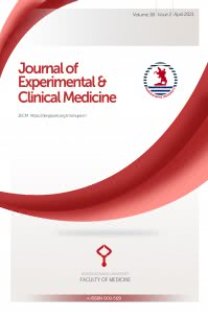Motor eşgüdümde dopaminerjik sistemin rolü
Reseptörler, dopamin D1, Reseptörler, dopamin D2, Modeller, hayvan, Modeller, teorik, Sıçanlar, Apomorfin, Dopamin antogonistleri, Sülpirid, Bromokriptin, Motor aktivite
The role of dopaminergic system in motor coordination
Receptors, Dopamine D1, Receptors, Dopamine D2, Models, Animal, Models, Theoretical, Rats, Apomorphine, Dopamine Antagonists, Sulpiride, Bromocriptine, Motor Activity,
___
1. Ghez C. Motor Systems of the brain: Reflex and voluntary control of movement. In Kandel ER, Schwartz J, Jessel TM. (ed.) Principles of Neural Science 3rd. ed. New York, 1991; 533-680. 2. Wichmann T, Delong MR. Functional pathophysiologycal models of the basal ganglia. Curr Opin Neurobiol 1996; 6: 751-758. 3. DeLong MR Primate models of movement disorders of basal ganglia origin. Trends Neurosci 1990; 13: 281-285. 4. Robertson HA, Dopamine receptor interactions: some implications for the treatment of Parkinson's disease. Trends Neurosci 1992; 15: 201-206. 5. Kayaalp SO. Rasyonel Tedavi Yönünden Tibbi Farmakoloji. 9. baskı, 1. cilt, Ankara, Feryal Matbası, 1999; 729-733. 6. Bunzow J, VanTol HHM, Grandy DK. Cloning and expression of a rat D2 dopamine receptor cDNA. Nature 1988; 336: 783-787. 7. Dearry A, Gingrich J A, Falardeau P et al. Moleculer cloning and expression of the gene for a human D1 dopamine receptors. Nature 1990; 347: 72-75. 8. al-Khatib İM. Dokmeci I, Fujiwara M. Differential role of nucleus accumbens and caudate-putamene in mediating the effect of nomifensine and methamphetamine on ambulation and rearing of rats in the open-field test. Jpn J Pharmacol 1995; 67: 69-77. 9. Garrett BE, Holtzman SG. Dl and D2 dopamine receptor antagonists block caffeine-induced stimulation of locomotor activity in rats. Pharmacol Biochem Behav 1994; 47: 89-94.10. Hirate K, Kuribara H, Characteristics of the ambulation-increasing effect of GBR-12909, a selective dopamine uptake inhibitor, in mice. Jpn J Pharmacol 1991; 55: 501-511. 11. Motles E, Gomez A, Tetas M et al. Effects of SCH 23390 and sulpirid on the behaviours evoked by amphetamine and apomorphine in adult cats. Prog Neuropsychopharmacol Biol Psychiatry 1993; 17: 1005-1022. 12. Dall'Olio R, Rimondini R, Gandolfi O. Effect of NMDA receptor antagonist on Dİ, D2 and D1/D2 mediated behaviors in intact rats. Psychopharmacology. 1996; 123: 187-190. 13. Dracheva S, Xu M, Kelley KA, et al. Paradoxical locomotor- behavior of dopamine Dl receptor transgenic mice. Exp Neuro!. 1999; 157: 167-819. 14. Kelley MA, Rubinstein M, et al. Locomotor activity in D2 dopamine receptor-deficient mice is determined by gene dosage, genetic background, and developmental adaptations. J Neurosci 1998: 18: 3470-3479. 15. Karasinska JM. George SR el al.Mod ification of dopamine D(l) receptor knockout phenotype in mice lacking both dopamine D(l) and D(3) receptors. Eur J Pharmacol 2000; 399: 171-181. 16. Liu X. Strecker RE, Brener JM. Low dose s of apomorphine suppress operanL motor performance in rats. Pharmacol Biochem Behav 1996: 53: 335-340. 17. Gerald MC, Gupta TK. The effects of amphetamine isomers on rotarod performans. Psychopharmacology (Berl) 1977; 55: 83-86. 18. Çelik S, Kabasakal L, Cevheroğlu Ş et al. Hareket hastalığına karşı kullanılan bazı ilaçların eşgüdümlü motor performans üzerine etkileri. GATA bülteni 1989; 31: 129-139. 19. Schwartz JC, Giros B, Maries MP et al. The dopamine receptor family: moleculer biology and pharmacology. Seminers in Neuroscience. 1992; 4: 99-108. 20. Kulingsjö H, Caıisson A, Svenson K, Effects of repeated administration of the preferanUal dopamine autoreceptor antagonists, (+)-AJ76, on locomotor activity and brain DA metabolism in the rat, Eur J Pharmacol 1991: 205: 241-246. 21. Mori T, Baba J, Ichimaru Y. Effects of rolipram, a selective inhibitor of phosphodiesferaz 4, on hiperlocomotion induced by several abused drugs in mice. Jpn J Pharmacol 2000: 83: 113-118. 22. Fredriksson A, Plaznik A., e t all.. Effects of Dl and D2 agonists on spontaneous motor activity in MPTP treated mice. Pharmacol Toxicol 1994; 75: 36-41. 23. Zarrindast M.R, Eliassi A. Differantial effects of dopamine agonists on locomotion in intact and reserpine-treated mice. Gen Pharmacol 1991: 22: 1027-1031.
- ISSN: 1300-2996
- Yayın Aralığı: Yılda 4 Sayı
- Başlangıç: 2018
Gaziantep il merkezindeki gebe kadınlarda A vitamin ve B-karoten düzeyleri
Şahin KILINÇER, İclal MERAM, Ali İhsan BOZKURT
The acanthosis nigricans associated with gastric adenocarcinoma and neurofibromatosis
Tayyar CANTÜRK, Levent YILDIZ, Asiye YILDIZ, Oğuz AYDIN, Ahmet Yaşar TURANLI
Çocukluk çağı kanser hastalarının epidemiyolojik incelenmesi
Nilgün ÖZBEK, Şaban ÇAKIR, Baki TARAKÇI, Melek COŞKUN
Sayit ALTIKAT, Mehmet Emin BÜYÜKOKUROĞLU, Mehemt ÇİFTÇİ, Nuri BAKAN, ÖMER İRFAN KÜFREVİOĞLU
Motor eşgüdümde dopaminerjik sistemin rolü
Mehmet KURT, Süleyman ÇELİK, Yüksel KESİM
Zahide DOĞANAY, Fikret BİLDİK, Dursun AYGÜN, Hakan GÜVEN, Levent ALTINTOP, Murat YERLİYURT
Şizofrenide risperidon ile olanzapinin karşılaştırılması
SEZGİN GÜNEŞ, Hasan BAĞCI, NURTEN KARA
Multipl sklerozda human lökosit antijen sıklığının incelenmesi
